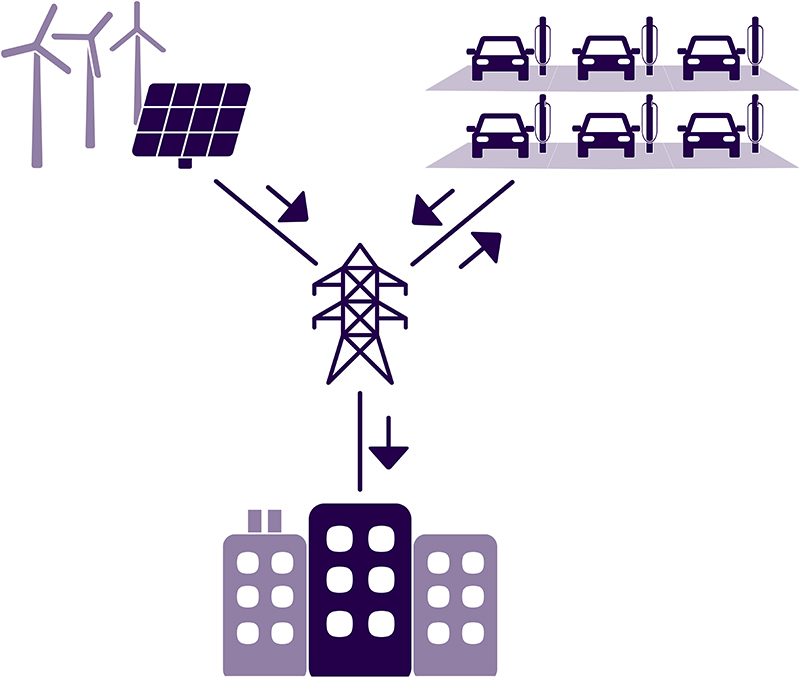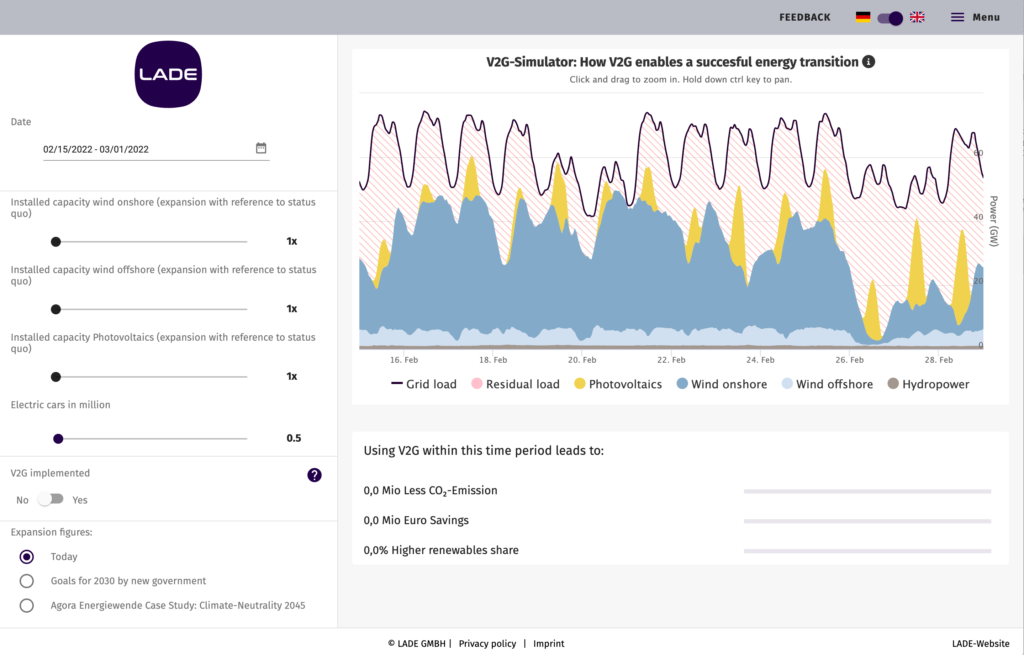Vehicle-to-Grid: A crucial contribution to the energy transition
Vehicle-to-Grid (V2G) is the key to efficient and cheap power supply with renewable energies. Our interactive tool makes the technology’s potential visually tangible.
What is Vehicle-to-Grid?
In Germany, CO2-free power supply works mainly via wind and solar energy. In order to ensure a permanent supply on an industrial scale, large, flexible energy storage is required.
Vehicle-to-Grid can provide this capacity easily, cheaply and efficiently. The batteries of electric vehicles are connected, creating a distributed and smartly controlled buffer storage.

Try it yourself!
LADE’s interactive V2G simulator helps you modelling the future of power supply both easily and technically well-founded. Based on real world data from the Bundesnetzagentur (German Federal Network Agency), the tool shows that almost the entire power supply in Germany can be guaranteed with wind power, solar energy and electric cars with bidirectional functionality.
Why is Vehicle-to-Grid worthwhile?
The future of individual transport is electric. This automatically creates a gigantic, distributed and mobile energy storage system. Exploiting this potential using V2G is highly rational, both ecologically and economically.
Private cars are parked most of the time and mainly are used for short trips. This creates ample room for network management. Smart control systems ensure sufficient battery levels at all times.
Because stable networks have high economic value, this can be extremely attractive financially for vehicle owners. In order to implement this, the political and regulatory conditions must be set today!
How can Vehicle-to-Grid be implemented?
In order for V2G to work, parked vehicles must always be connected to the grid – therefore, more charging points than vehicles are needed. Economically reasonable, this can only be realised with AC charging infrastructure.
Bidirectional charging with DC chargers creates significantly higher costs in production and operation. The infrastructure would consume vast amounts of subsidies or be limited to few use cases such as private homes. Only a tiny fraction of the available storage capacity could be used.
BEV, on the other hand, can be equipped for bidirectional AC charging with very little effort – if the onboard chargers needed isn’t already installed, anyway. Smart, networked charging infrastructure facilitates communication between network operators, vehicles and drivers.

Develop the climate-neutral power supply of the future with us!
Are you scientifically or professionally active in the areas of electricity (markets), smart grid or (e-)mobility? We look forward to innovative collaboration! Feel free to contact us via v2g@lade.de!
Frequently asked questions about Vehicle-to-Grid
The technology for Vehicle-to-Grid is essentially developed and is already being used in pilot projects. Vehicles are an important factor here, as they have to offer a bi-directional charging function, ideally with both alternating current (AC) and direct current (DC). It is just as crucial that politicians create fair, open framework conditions. Important issues such as billing, taxes, network quality as well as communication between the vehicle, network and charging infrastructure need to be regulated. Vehicles with a bidirectional charging function are already on the market, but currently it can be assumed that Vehicle-to-Grid will not be rolled out on a large scale until between 2025 and 2030.
Electric vehicle are primarily built for driving – and Vehicle-to-Grid/V2G doesn’t change that. The owner alone decides whether a vehicle is available for V2G or not. If a fully charged car is needed, a fully charged car is available.
When a vehicle is used for Vehicle-to-Grid, smart systems, user communication and artificial intelligence ensure that the battery’s state of charge always corresponds to individual needs. For example, the LADEcloud can learn how much electricity is needed for the daily commute to work. Alternatively, a fixed minimum state of charge can be defined.
Vehicle-to-Grid/V2G increases the number of charging and discharging processes compared to simple charging. The quality of battery cells, however, has nowadays improved greatly, which is why the service life of the batteries is hardly compromised. Some car manufacturers are now even developing batteries specifically for purposes like bidirectional charging.
In any case, the higher the charging/discharging power, the greater the wear. A low discharge power of 11 kW is sufficient for V2G, while values of up to 200 kW can be achieved when accelerating on the motorway or during fast charging. So Vehicle-to-Grid puts much less strain on the battery than a sporty driving style. It can even be advantageous for batteries if the charge level fluctuates between 20 and 80 percent with low current flows – some people even call this “caressing the battery”.
This depends on the individual case. However, more and more manufacturers are starting to offer bidirectional charging for their vehicles and design the batteries for Vehicle-to-Grid and similar functionalities. It can be expected that the battery warranty should be extended accordingly.
In order for Vehicle-to-Grid to work, electric vehicles must be connected to the grid as often as possible: not only at home, but also at work, when shopping, at the gym, etc. Therefore, the number of charging points needs to be significantly higher than the number of electric cars.
DC (direct current) charging infrastructure is more complex, expensive and resource-intensive than AC (alternating current) charging infrastructure. From an economic and ecological point of view, it makes sense to put great emphasis on AC charging. This still applies if you take into account the additional effort needed to install bidirectional onboard chargers in the vehicle.

